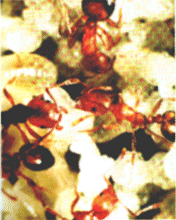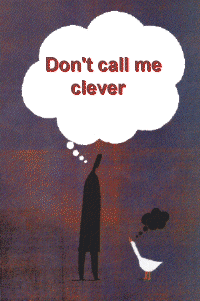
If you think it's smart to be brainy there are two things
you should know: a limited intellect is usually beneficial; and creativity
is often the last resort for losers. Behavioural biologist Simon M. Reader
reveals the pros and cons of intelligence
Simon M. Reader
AT FIRST glance, Homo sapiens seems an unlikely
candidate for world domination. Our bodies are puny and defenceless, with
none of the obvious trappings of a top predator. But no matter, the secret
of our success is measured not in brawn but in brains. That makes it tempting
to rate the creativity and complex learning abilities that characterise human
intelligence as the pinnacle of evolution. Tempting, but wrong.
Think about it. If our kind of intelligence is such a good thing, why is
it unique in nature? Given around 1.8 billion years of evolution since life
began, you might expect other organisms to have come up with the same winning
formula. Yet our big brains are the exception, not the rule. Most animals
get by perfectly well with tiny brains and apparently limited learning abilities.
Perhaps the combination of a large brain and advanced intelligence isn't
a universal winning ticket in the evolution lottery, but is instead just
another evolutionary adaptation.
This perspective raises some key questions. What is
intelligence good for and, more importantly, what is it bad for? Are
humans unique in having taken an evolutionary path that emphasises intelligent
behaviour, or have other animals taken a similar route? How do we know which
animals are smarter than others, anyway? One surprising conclusion is that,
often, it pays to have limited intelligence. Another is that where intelligence
has evolved it may have been driven by struggling losers rather than successful
individuals.
Advanced learning skills form a fundamental part of what we term intelligent
behaviour. Superior learning abilities may initially appear unquestionably
useful, but this is far from a universal truth. Animals that instinctively
know which predators to avoid, which foods to eat, or what their mother looks
like, are less vulnerable than those that have to learn such skills. Learning
takes time, and you risk making mistakes: if you happen to be looking at
a flower while everybody else is freaking out over a snake, you could end
up with a mistaken fear of tulips. Still, many animals, from fish to monkeys,
do learn about potential sources of danger from others. But they usually
have in-built predispositions that influence the kinds of things they can
learn. Rhesus macaques, for example, learn from other macaques to fear snakes
more readily than flowers.
But other costs of learning are unavoidable. Brain tissue is among the most
energy-hungry of all body tissues. Around 20 per cent of your resting metabolism
goes to supplying the energy demands of your brain, compared with ~ per cent
in a typical smaller-brained mammal. Then there's the cost of protecting
this sensitive structure from mechanical and physiological shocks, which
means a thick skull, specialised temperature regulation, and adaptations
for precisely controlling the brain's chemical environment. Larger brains
also take longer to develop, so parents must invest additional time and energy
in gestating and raising each offspring. All this means larger-brained animals
could be at a substantial reproductive disadvantage compared with their
smaller-brained
counterparts.
Proving this experimentally is difficult, but one recent study provides a
fascinating insight into why many species remain less intelligent. Frederic
Mery and Tadeusz Kawecki at the University of Fribourg in Switzerland were
able to breed a strain of fruit flies that was smarter than average. To do
this, the insects were allowed to feed on orange and pineapple-flavoured
jellies, one of which contained bitter-tasting quinine. Later, the flies
could choose to lay their eggs on either flavour jelly -both now without
the bitter taste - but only eggs laid on the flavour that was not previously
tainted were allowed to develop into adults. With each subsequent generation,
the researchers switched the flavour containing the bitter taste, to ensure
that they were selecting flies with better memories rather than a preference
for a particular jelly flavour.
They found that within 20 generations their flies had better learning abilities
than control flies on a variety of tasks. But the clever individuals weren't
some kind of super-fly:
in domains other than learning their more stupid cousins had the upper hand.
For example, larvae of flies bred for cleverness did worse than those of
regular flies when competing for limited food (Proceedings of the Royal Society
of London, vol 270, p2465).
Clearly the lab is an artificial environment for
fruit flies, and the costs and
benefits of intelligence will be different in the wild, but this experiment
reveals that while improved learning capacities may increase an individual's
survival chances in one arena, it can reduce them in others. Natural selection
will ensure that increased intelligence evolves only in those species where
the total benefits outweigh the costs.
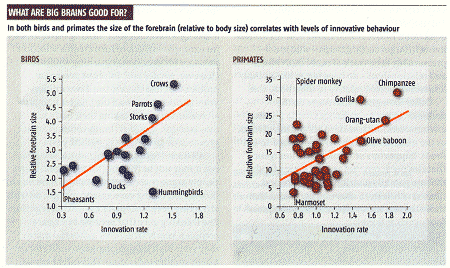
Ever since Darwin, biologists have been interested
in what kinds of species demonstrate intelligent behaviour, and why. The
consensus is that environmental variability is the key. Mathematical models
such as those developed by Peter Richerson from the University of California,
Davis, and Robert Boyd from the University of California, Los Angeles, reveal
that when the environment is changing slowly, an organism's best option is
genetically encoded stock responses. However, as the environment changes
more rapidly, learning becomes a better strategy for survival. At intermediate
rates of change, the ideal tactic is learning from others - social learning.
At more rapid rates, individual learning works best.
Different theories and different researchers emphasise different aspects
of environmental variability to explain the evolution of intelligence.
Social-intelligence hypotheses focus on the benefits of braininess in dealing
with a rapidly changing social world. They argue that intelligence helps
individuals cope with the demands of social living, allowing them to gain
information from others to behave unpredictably - which may be key in outwitting
rivals. Thus clever individuals may not only cope better with variability
but may actively create variability in their own behaviour. And research
shows that mammals living in larger social groups - who must presumably keep'
track of more individuals and relationships - do have larger brains than
less social species, relative to their body size.
Other biologists focus more on the demands of tracking changes in the physical
environment, such as the distribution of food, or the need to learn how to
access hard-to-eat foods. Supporters of "ecological intelligence" theories
point out that species eating foods that are patchily distributed in space
and time - such as fruit - have bigger brains than those that eat more
dependable, widespread foods such as leaves.
Then there are researchers who suggest that intelligence evolves as a result
of positive feedback. They propose that more intelligent species tend to
expose themselves to more variable environmental situations where learning
is advantageous - eating novel foods, for example - which in turn creates
selection pressure for even better learning abilities. However, whales and
dolphins present a problem for this theory. Until two million years ago cetaceans
had the biggest brains of all mammals - even taking their body size into
account - yet their brain volumes have grown little in the past 15 million
years.
All these theories invoke natural selection, but it may not be the only force
at work. Some people argue that cognitive abilities have less to do with
increasing survival and more to do with attracting or choosing mates - sexual
selection. The thinking goes that because brains are complex, costly structures,
potential mates may view high intelligence as an indicator of a high-quality
individual. This might explain why some male songbirds have such an extensive
vocal repertoire, for instance.
Geoffrey Miller of the University of New Mexico in Albuquerque has used a
similar argument to explain human intelligence. If generations of our ancestors
preferred to mate with innovative and creative individuals this would have
shaped the evolution of all brains in much the same way that the peacock
preferences have shaped the peacock's tail. There is evidence that sexual
selection has produced larger brains in some bowerbirds but its part in the
evolution of human brains remains firmly at the nice-idea stage.
Nevertheless, all this theorising suggests that there are a variety of reasons
why some species might find that the benefits of evolving big, intelligent
brains outweigh the costs. In our own species this process has led to a
particular kind of learning strategy, characterised by creativity and cultural
transmission - the spread of ideas and know-how from person to person. We
humans are innovators par excellence, rivalling evolution's powers of invention
by at least one yardstick:
the number of registered patents outnumbers the living species that have
been discovered. We also have an outstanding cultural diversity. What's more,
we are especially good at learning from one another, and think nothing of
feats such as learning by imitation, which even our closest relative the
chimpanzee struggles to do.
So how unique is our kind of intelligence? Experiments with chimps and other
higher primates reveal exciting, albeit controversial, parallels with human
cognition. But comparing the mental abilities of animals as varied as ants,
albatrosses and aardvarks is even more tricky. Obviously you can measure
brain size, but are animals with large brains actually more intelligent?
We routinely use words like "brainy" as synonyms for intelligence, and even
animal behaviourists have assumed they equate, but in fact we have only recently
been able to confirm that bigger brains do indeed provide superior cognitive
abilities. Even now, controversy rages over why big brains should be better.
Meanwhile we have struggled to find a fair test to compare the cognitive
abilities of a wide range of species, but recent years have seen a breakthrough.
A growing number of researchers, including myself have been focusing on
innovation - the invention of novel behaviour patterns - as a measure of
species' cognitive differences in one of the most human of all intellectual
abilities, creativity.
This line of enquiry took off about seven years ago when Louis Lefebvre at
McGill University in MontreaL Canada, realised that he could plunder the
many publications devoted to birdwatching to glean comprehensive and reliable
information about innovation in birds. Kevin Laland from the University of
St Andrews in Scotland and I made a similar study of ii6 primate species,
also using published scientific
reports of individuals' novel behaviour as an index of innovativeness. Both
studies found that those animals with the largest brains relative to their
body size were also the most innovative (see Diagram, p35) (Brain, Behavior
and Evolution, vol 63, p233). Thus it seems that for at least one measure
of intelligence -innovativeness - there is indeed a link between brain volume
and cognitive capacity.
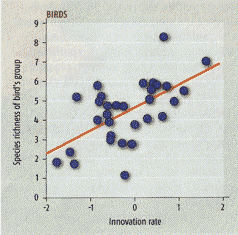
These studies of innovation give us an unusual insight into the behaviour
of a wide variety of animals in the wild. They can also provide clues to
the evolutionary benefits and repercussions of innovative minds. In an intriguing
follow-up to Lefebvre's work, Daniel Sol, now at the University of Barcelona
in Spain, again took advantage of the fantastic record-keeping of bird
enthusiasts to investigate how innovation affects survival. He looked at
the 100-plus species of birds that human immigrants had introduced into New
Zealand, often in deliberate attempts to recreate the fauna of their homeland.
Combining detailed data on the success of these introduced species with
Lefebvre's avian innovation database, Sol found species that were innovative
in their original habitat were more likely to survive in New Zealand. For
these birds at least, innovativeness seems to have helped in the struggle
to cope with a new environment.
Even more noteworthy is the finding by Lefebvre and colleagues that innovation
may affect the evolutionary process itself with innovative lines of birds
evolving more rapidly than less inventive lineages (see Diagram, above) (Animal
Behaviour, vol 6~, p445).
Studies of innovation reveal a wide range of creative ability in the animal
world. While a monkey eating a new kind of root hardly seems to be making
a cognitive leap, chimpanzees that create novel and highly effective courtship
displays, such as flipping their upper lips over their noses, are more
impressive. And top marks must surely go to Betty the New Caledonian
crow who, when faced with a food
basket at the bottom of a plastic tube, bent a piece of wire to make a
hook-shaped tool to access the food: a novel solution to a novel problem
(New Scientist, 17 August 2002, p44).
But does even Betty demonstrate the same kind of creativity involved in human
innovation? This question remains difficult to answer because we have only
a rudimentary understanding of the mental processes involved. Many cases
of innovation - including human creativity - can be explained in terms of
simple trial-and-error learning, without the need for special cognitive skills,
although Betty's achievements would be difficult to explain in these terms.
The next challenge is to determine what is going on inside innovative minds,
both human and animal, so we can see exactly what makes human creativity
so special.
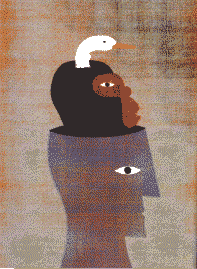 In one way, at least, the creative talents of animals do seem to mirror
those of humans. In those animals examined up to now the adage "necessity
is the mother of invention" rings true. My own experiments with guppies reveal
that hungry, small and uncompetitive fish tend to be the most innovative.
And among primates, innovators are usually individuals of low social rank.
In humans too, innovation is often used only when things are going badly.
Businesses and individuals both tend to stick to tried-and-tested formulas
if they can.
In one way, at least, the creative talents of animals do seem to mirror
those of humans. In those animals examined up to now the adage "necessity
is the mother of invention" rings true. My own experiments with guppies reveal
that hungry, small and uncompetitive fish tend to be the most innovative.
And among primates, innovators are usually individuals of low social rank.
In humans too, innovation is often used only when things are going badly.
Businesses and individuals both tend to stick to tried-and-tested formulas
if they can.
If inventiveness were indeed a universal panacea, this reluctance to use
it might seem bizarre. But once you understand that intelligence is just
another survival strategy, it makes more sense. Innovation may provide benefits,
such as novel food sources or more efficient foraging
techniques, but it also carries costs - the risk of poisoning or the
energy wasted trying something new that doesn't work out. In humans, pursuing
innovation at the wrong time has led to numerous bankruptcies and even death.
So we should expect those animals using their full creative potential to
be either individuals who can afford to bear the potential costs of their
experimentation or those in such dire need that they are turning to innovation
as a last resort. It's a high-risk strategy, but
if the gamble pays
off they might just hit the evolutionary jackpot.
In other words, the story of the evolution of human creative intelligence
is perhaps not one of successful individuals innovating to do still better,
but rather one of losers innovating to do less badly.
"Intelligence may even affect the
evolutionary process itself, with innovative animals evolving more rapidly
than less inventive ones"
Birds with larger brains are not only more innovative but also belong to
groups with greater numbers of species, suggesting that intelligence may
speed up the rate of evolution
New Scientist 137
Angles show ants the way home
|
